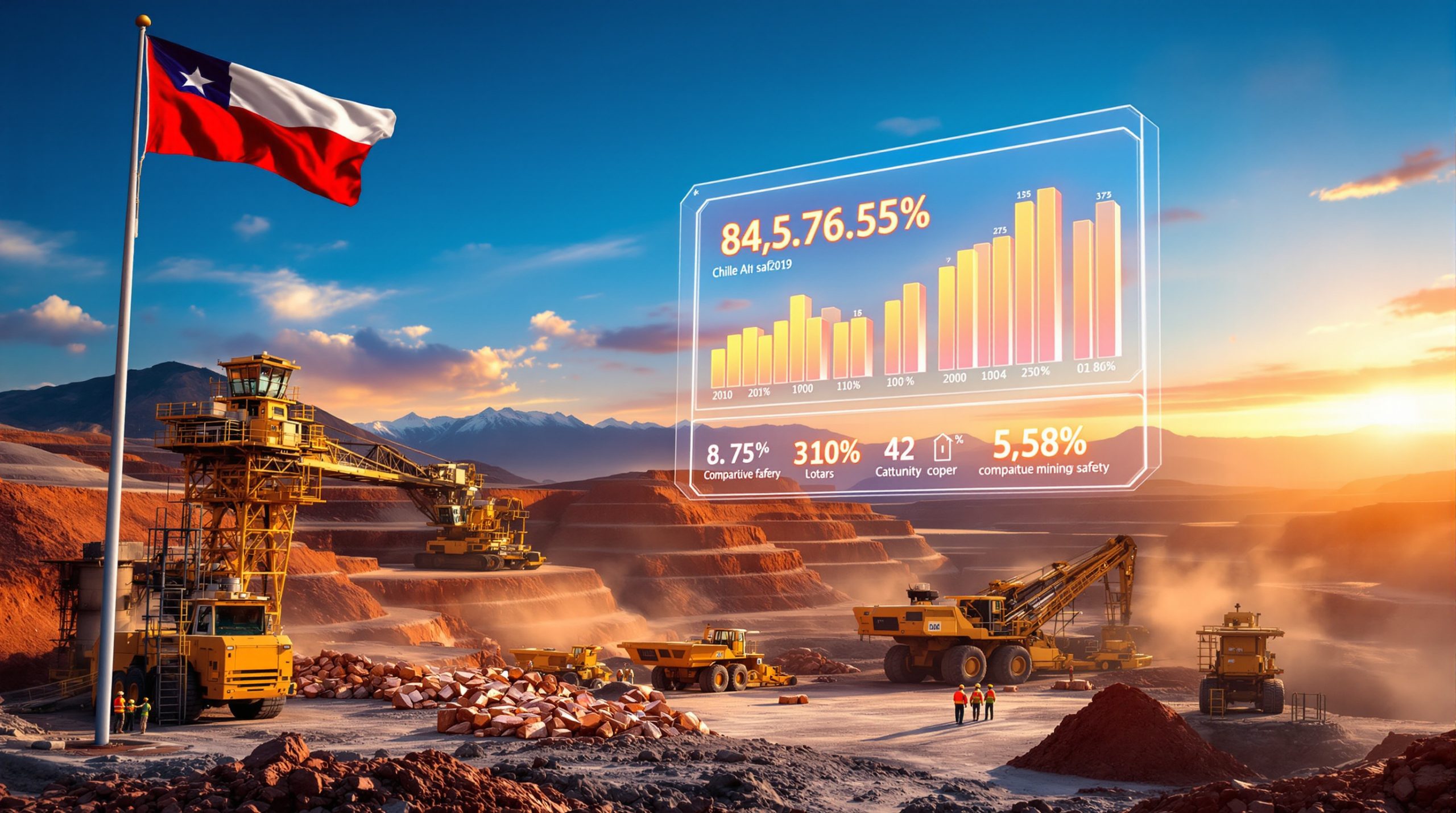Copper Output from Codelco Climbs 15% in March
Chile's state-owned copper giant Codelco reported a significant production increase in March 2025, marking a notable turnaround for the world's largest copper producer. This surge comes at a critical time for global copper markets, as demand for the essential red metal continues to grow amid global energy transition efforts.
Understanding the Recent Production Surge
Codelco's copper production reached 123,200 metric tons in March 2025, representing a robust 15% year-over-year increase according to Chile's Copper Commission (Cochilco). This production boost reinforces Codelco's position as the world's largest copper producer and signals potential improvements in operational efficiency.
"The March figures represent one of the strongest monthly performances for Codelco in recent years," noted mining analyst Carmen Vásquez from Santiago-based consultancy CopperInsights. "This growth trajectory suggests their operational enhancement programs are beginning to yield tangible results."
The production increase is particularly noteworthy given the challenging geological conditions miners face in Chile's aging copper deposits. Many of Codelco's mines have been in operation for decades, with declining ore grades requiring more sophisticated extraction techniques to maintain productivity.
Beyond the immediate production figures, this growth carries significant implications for global copper markets. As the world's leading copper producer, Codelco's output directly influences global copper supply forecast dynamics, potentially affecting price trends and material availability for downstream industries.
What Factors Are Driving Codelco's Production Growth?
Several key factors appear to be contributing to Codelco's impressive production resurgence, reflecting a combination of strategic investments and operational improvements.
Operational Improvements
Codelco has implemented advanced mining techniques across its operations, including autonomous haulage systems at its Chuquicamata underground mine and predictive maintenance systems that reduce costly downtime. These technologies allow for more efficient resource extraction while improving worker safety.
"The digital transformation initiative launched in 2023 is now delivering measurable productivity gains," explained Roberto Echeverría, Codelco's Chief Technology Officer. "Our investment in predictive analytics has reduced unplanned maintenance by approximately 32% at our largest operations."
The company has also optimized processing facilities, implementing more effective ore sorting technologies that better separate valuable copper from waste rock, improving recovery rates by an estimated 8-10% at modernized facilities.
Investment Impact
Codelco's $40 billion structural projects program, initially announced in 2021, is now bearing fruit. The ongoing transformation of major mines from open-pit to underground operations has overcome initial challenges, with the Chuquicamata Underground and Rajo Inca projects now contributing significantly to overall production.
According to Codelco's 2024 annual report, capital expenditures reached $4.8 billion last year, representing one of the most aggressive investment phases in the company's history. These investments focused on extending mine life, improving operational efficiency, and incorporating environmental sustainability features.
Strategic Priorities
The production increase aligns perfectly with Chile's national economic priorities. Mining contributes approximately 15% of Chile's GDP and over 50% of its export revenue, making Codelco's performance crucial to national economic health.
"Codelco's strategic importance to Chile cannot be overstated. As a state-owned enterprise, its success directly translates to funding for public services and infrastructure development," explains economic historian Dr. Manuel Reyes of the University of Chile. "The government's push for production efficiency reflects this critical relationship."
The company has also focused on recovery from previous challenges, including pandemic-related operational constraints and a series of technical issues that hampered production in 2023. Water availability, a persistent challenge in Chile's arid mining regions, has been addressed through significant investments in desalination infrastructure.
How Does Codelco's Performance Compare to Other Major Copper Producers?
While Codelco leads global copper production as a company, individual mines from other operators continue to challenge its dominance in terms of single-site output.
BHP's Escondida Mine Performance
BHP's Escondida mine, the world's largest individual copper operation, reported an impressive 19% production increase, reaching 120,600 tons in March 2025 according to Cochilco data. This nearly matches Codelco's entire corporate output, despite being a single mine operation.
Escondida's continued strong performance comes from several advantages:
- World-class ore grades averaging 0.72% copper (compared to the global average of 0.5%)
- Advanced leaching technology capturing previously unrecoverable copper
- Significant economies of scale from massive production volumes
- Consistent investment in water security through its desalination plants
Escondida's strategic position remains secure as BHP continues to prioritize copper as a "future-facing" commodity essential to global electrification efforts.
Collahuasi Mine Challenges
In stark contrast to the success stories at Codelco and Escondida, the Collahuasi mine experienced a dramatic 29% production decline, with output falling to 35,200 tons in March 2025. This underperformance is particularly concerning given Collahuasi's historical position as Chile's second-largest copper mine.
Collahuasi's challenges appear to stem from multiple factors:
- Technical difficulties with its crushing circuit, which experienced major equipment failures in February 2025
- Water supply constraints affecting processing capacity
- Labor disruptions during contract negotiations earlier in the quarter
- Lower-than-expected ore grades in recently developed mining sectors
As a joint operation between Glencore (44%), Anglo American (44%), and Japan Collahuasi Resources (12%), Collahuasi's management structure adds complexity to decision-making processes, potentially slowing response times to operational challenges.
| Producer | March 2025 Production (tons) | Year-over-Year Change |
|---|---|---|
| Codelco (all operations) | 123,200 | +15% |
| BHP (Escondida) | 120,600 | +19% |
| Glencore/Anglo (Collahuasi) | 35,200 | -29% |
| Freeport-McMoRan (El Abra) | 18,400 | +8% |
| Antofagasta (Los Pelambres) | 31,500 | +4% |
What Are the Market Implications of Codelco's Production Increase?
The significant production growth from Chile's largest producer creates ripple effects throughout global copper markets and Chile's domestic economy.
Global Copper Supply Dynamics
Codelco's 15% production increase contributes to stabilizing global copper supply amid growing demand pressures. The International Copper Study Group (ICSG) forecasts a marginal global deficit of approximately 142,000 metric tons for 2025, down from 218,000 tons in 2024, partially attributable to production increases like Codelco's.
This supply growth comes at a critical juncture as copper inventories at major exchanges have dwindled to concerning levels. London Metal Exchange (LME) warehouses reported copper stocks of just 145,000 tons in April 2025, representing less than three days of global consumption.
"Improved production from major miners like Codelco helps alleviate immediate supply concerns, but structural deficits remain a medium-term challenge," explains commodities strategist Sarah Chen from Goldman Sachs. "The energy transition continues to drive surging copper demand analysis that outpaces supply expansions."
The production increase has helped moderate copper price pressures, with LME copper trading at $11,750 per metric ton in early May 2025, down from peaks above $12,200 earlier in the year. However, prices remain historically elevated, supported by strong fundamental demand.
Chile's Copper Industry Position
Codelco's production resurgence reinforces Chile's role as the world's leading copper producer, contributing significantly to the country's economic health. Copper exports generated $52.7 billion for Chile in 2024, representing approximately 48% of total export revenue according to Chile's Central Bank.
The improved production outlook has positive implications for Chile's fiscal position, as Codelco contributes all profits directly to the national treasury. In 2024, these contributions reached $3.8 billion despite operational challenges, with 2025 projections now revised upward based on improved production performance.
"Chile's mining sector, led by Codelco, serves as the economic foundation of our nation," stated Finance Minister Carolina Mella. "Sustainable production growth translates directly to enhanced public services and infrastructure development for all Chileans."
Despite these positive developments, Chile faces increasing competition from emerging copper-producing nations, particularly the Democratic Republic of Congo, which has rapidly expanded production through major investments from Chinese mining companies.
What Challenges and Opportunities Lie Ahead for Codelco?
Despite recent production success, Codelco faces significant challenges to maintain its competitive position while addressing sustainability imperatives.
Strategic Development Priorities
Ensuring continued output growth amid resource constraints presents a fundamental challenge. Many of Codelco's mines have been in operation for decades, with declining ore grades requiring deeper and more complex extraction methods. The average ore grade across Codelco's operations has fallen from 1.2% in the 1990s to approximately 0.7% today.
To address these challenges, Codelco has prioritized:
- Technological innovation: Implementing advanced mining technologies including autonomous equipment, AI-powered predictive maintenance, and improved ore sorting systems
- Underground transitions: Converting aging open-pit mines to underground operations, with the $7.9 billion Chuquicamata Underground project now ramping up to full production
- Resource optimization: Improving recovery rates from existing operations through process enhancements and reprocessing of historical tailings
- Exploration investment: Allocating $380 million to exploration activities in 2025 to identify new resources
Environmental compliance represents another significant challenge. Codelco has committed to reducing its carbon emissions by 70% by 2030, necessitating major investments in renewable energy infrastructure and electrification of mining equipment.
"Our sustainability roadmap requires approximately $15 billion in investment over the next decade," noted Codelco's Sustainability Director Javiera Contreras. "We're transitioning from diesel to electric vehicles across our operations and have signed agreements for 2.3 gigawatts of renewable energy capacity."
Market Positioning Considerations
Global demand trends present substantial opportunities for Codelco, particularly in relation to energy transition technologies. The average electric vehicle contains approximately 83 kg of copper, more than four times the amount used in conventional vehicles. Similarly, renewable energy systems require 4-12 times more copper than fossil fuel alternatives.
The International Energy Agency projects copper demand for clean energy technologies will grow from 4.5 million tons in 2023 to over 8.7 million tons by 2030, creating a robust demand foundation for producers like Codelco.
Competitive dynamics continue to evolve as copper mining expands globally. While Chile remains the world's largest copper producer, its market share has declined from 35% in 2000 to approximately 27% today. Emerging producers in Peru, Indonesia, and the DRC present increasing competition, often with higher-grade deposits and lower production costs.
Codelco is exploring value-added opportunities through potential downstream investments. The company is conducting feasibility studies for copper semi-fabrication facilities that would produce higher-value copper products rather than simply exporting concentrate and cathodes.
"Chile has historically been a primary materials exporter, but our national development strategy now emphasizes moving up the value chain," explains economist Patricia Rodríguez of the Chilean Economic Development Agency. "Codelco could play a pivotal role in this transition."
Frequently Asked Questions About Codelco's Copper Production
What is Codelco's significance in the global copper market?
Codelco stands as the world's largest copper producer, controlling approximately 10% of global copper reserves according to the U.S. Geological Survey's 2025 Mineral Commodity Summary. The company produced 1.45 million metric tons of copper in 2024, representing approximately 8% of global mine production.
Beyond its production volume, Codelco's strategic decisions significantly influence market sentiment and copper price predictions. As a state-owned enterprise, its production and investment choices reflect both commercial considerations and Chile's national economic priorities.
How does Codelco's March 2025 production compare to historical performance?
The 15% year-over-year increase represents a notable improvement over Codelco's recent operational challenges. The company experienced three consecutive years of production declines from 2021-2023, with output falling from 1.73 million tons in 2020 to 1.35 million tons in 2023.
March 2025's strong performance suggests Codelco's operational turnaround strategies are gaining traction. The monthly output of 123,200 tons, if maintained throughout 2025, would put the company on track for annual production of approximately 1.48 million tons, still below historical peaks but representing meaningful recovery.
What impact might Codelco's production increase have on copper prices?
While increased production typically exerts downward pressure on commodity prices, copper's unique supply-demand dynamics create a more complex picture. The modest price decline observed following Codelco's production announcement reflects this balance between improved supply and robust demand fundamentals.
Analysts from major financial institutions including JPMorgan and Citigroup maintain copper price forecasts averaging $11,500-12,200 per ton through 2025, suggesting the production increase may moderate but not fundamentally alter the market's bullish outlook.
Copper's critical role in energy transition technologies, including electric vehicles, renewable energy systems, and grid infrastructure, creates durable demand that may absorb additional supply without significant price deterioration.
How does Chile maintain its competitive position in global copper markets?
Chile maintains its leadership position through several key advantages:
- Geological endowment: The country possesses 23% of global copper reserves according to the USGS
- Technical expertise: Decades of copper mining have created world-class human capital and knowledge base
- Infrastructure: Well-developed transportation, water, and energy systems support efficient operations
- Political stability: Relative to other major copper regions, Chile offers predictable operating conditions
- Research investment: Public-private partnerships advance mining technology innovation
However, Chile faces increasing challenges, including water scarcity in northern mining regions, declining ore grades, and growing environmental requirements. The country's ability to address these challenges while maintaining production efficiency will determine its long-term competitive position.
"Chile's copper industry stands at a critical juncture," observes mining economist Francisco Velasco. "The production increases we're seeing from Codelco demonstrate resilience, but maintaining global leadership will require continued innovation and strategic investment."
Chile's regulatory framework, while demanding increasingly stringent environmental compliance, provides the stability necessary for long-term capital investment. The country's mining law, established in 1983 and periodically updated, offers secure property rights while requiring responsible resource development.
Future Outlook for Codelco and Global Copper Markets
Looking ahead, Codelco's production trajectory will significantly influence both Chile's economic health and global copper availability. The company's $40 billion structural projects program aims to maintain annual production above 1.7 million tons through 2030, though analysts remain divided on whether these targets are achievable given geological and technical constraints.
From a global perspective, copper market fundamentals appear supportive of continued strong pricing. The World Bank forecasts a structural deficit emerging by 2026 as demand growth outpaces new mine development, potentially resulting in sustained price strength over the medium term.
For investors and industry observers, Codelco's performance serves as a crucial barometer for the broader copper mining sector's ability to meet growing demand from clean energy technologies while navigating increasing production challenges at aging mines. Furthermore, the recent US copper project insights and evolving copper investment insights highlight the global scope of efforts to expand copper output to meet future demand.
Want to Invest in the Next Major Copper Discovery?
Discover investment opportunities in emerging copper producers before they make headlines with Discovery Alert's proprietary Discovery IQ model, which transforms complex mineral data into actionable insights for ASX investors. Explore how significant mineral discoveries can generate substantial returns by visiting Discovery Alert's dedicated discoveries page and position yourself ahead of the market with immediate, real-time alerts.




